Clancy Tucker's Blog, page 207
October 23, 2016
24 October 2016 - MOVING PICTURES
[image error]
MOVING PICTURES
G'day folks,
You know I love these, so here are some more fabulous moving pictures. Some are stunning.



[image error]




[image error]
[image error]
[image error]
[image error]
[image error]
[image error]

[image error]
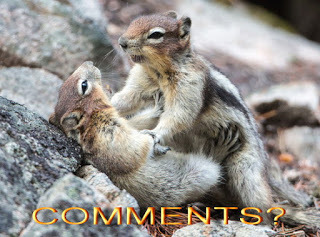
Clancy's comment: Very clever.
I'm ...

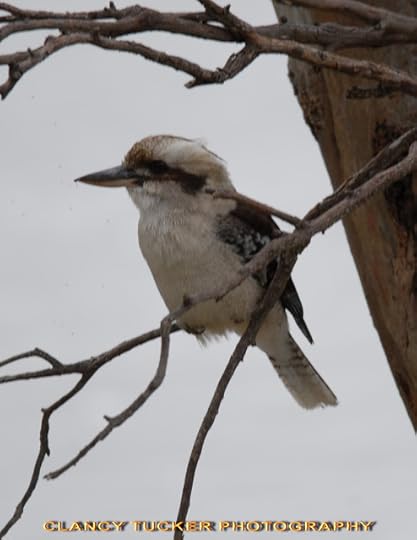
MOVING PICTURES
G'day folks,
You know I love these, so here are some more fabulous moving pictures. Some are stunning.



[image error]




[image error]
[image error]
[image error]
[image error]
[image error]
[image error]

[image error]

Clancy's comment: Very clever.
I'm ...


Published on October 23, 2016 12:47
October 22, 2016
23 October 2016 - CHRISSIE HYNDE

CHRISSIE HYNDE
G'day folks,
Welcome to some background on a great singer and activist. Chrissie Hynde came to fame as the frontwoman for the Pretenders. Hits "Brass in Pocket" and "My City Was Gone" became rock anthems in the 1970s and '80s.
Synopsis
Singer, songwriter, and guitarist Chrissie Hynde was born September 7, 1951, in Akron, Ohio. Her band, The Pretenders, got together in the late 1970s and released a self-titled album in 1980. She and bandmate James Honeyman-Scott penned the group's first hit, "Brass in Pocket." Subsequent releases produced the hit songs "Middle of the Road," "Show Me" and "I'll Stand by You."
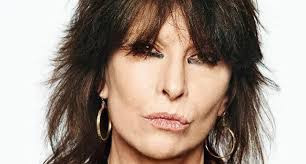
Singer, songwriter and guitarist Christine Ellen Hynde was born on September 7, 1951, in Akron, Ohio. Hynde was one of the leading women in rock in the 1980s and '90s as the lead singer of the Pretenders. After studying art at Kent State University for a time, she took off for London, England, where she discovered the emerging new rock genre called "punk."

The Pretenders
The Pretenders got together in the late 1970s and released a self-titled album in 1980. Hynde and bandmate James Honeyman-Scott penned the group's first hit, "Brass in Pocket." Subsequent releases produced the hit songs "Middle of the Road," "Show Me" and "Back on the Chain Gang" (from 1984's Learning to Crawl); and "Don't Get Me Wrong" (from 1986's Get Close); as well as 1994's "I'll Stand by You."
In 2005 the group was inducted into the Rock and Roll Hall of Fame. In 2015 Hynde released the autobiography Reckless: My Life as a Pretender.
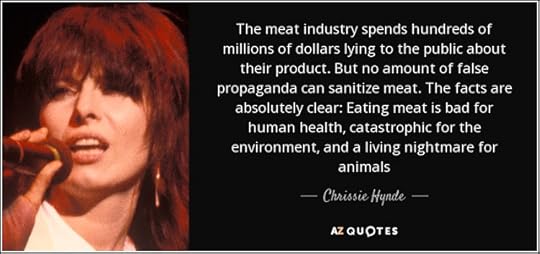
Chrissie Hynde divorced Simple Minds singer Jim Kerr in 1990 after six years of marriage. Together they have a daughter, Yasmin. Hynde also has a daughter, Natalie, with her former longtime partner Ray Davies of the Kinks.

Clancy's comment: Just love the pretenders.
I'm ...

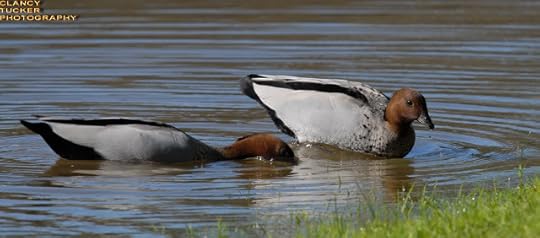
Published on October 22, 2016 13:38
October 21, 2016
22 October 2016 - LYNDA BOUCHARD - Guest Publicist

LYNDA BOUCHARD- Guest Publicist -
G'day folks,
Today, I welcome you to an interview conducted with a publicist from the USA.
Welcome, Lynda ...

1. WHY DID YOU BECOME A PUBLICIST?
During my ‘former life’ as a flight attendant for a major airline, I had the great pleasure of meeting Connie May Fowler, author of River of Hidden Dreams, on a flight from SFO-BOS. We talked about literature, writing, travel and everything in between. She had events in Boston the following day. Without hesitation, I offered to take her around since I had a 48 hour layover and an intimate knowledge of Boston. Ms. Fowler is a Southerner, born in North Carolina where I live now and where I was based during my airline career. She shared that her publisher didn’t know anything about the South or where to send authors in that market. I saw a specific void that needed to be filled in the publishing world - that of a liaison between author and publisher. It was a gift for me, meeting Connie May Fowler. I pitched my idea to the major publishing houses in New York. They loved it and they hired me to set up book tours in the South (USA). I began driving all over the South with authors on my days off! When I resigned from flying following the 9/11 attacks, I kicked it into high gear, expanded my services and the cities I covered. For over 15 years now I have assisted some of the most famous authors on the planet with their marketing, publicity, writing and editing.
2. WHAT DO YOU ENJOY ABOUT YOUR JOB?
Every day is different and holds sublime wonder when working closely with authors. I grow and learn from them, they advance and learn from me. It is a magical alchemy.
3. WHAT DO YOU DISLIKE ABOUT YOUR JOB?
Because I own ‘boutique’ PR agency, I can’t take on every author who wants to work with me. That’s tough because every writer deserves the best chance at success they can get. But by staying small, I remain agile with marketing efforts. Every book has unique aspects to it. My goal is to focus and creatively customize each project so it means saying ‘no’ and that never gets easier.
4. HOW MANY AUTHORS DO YOU ‘MANAGE’?
I manage expectations – not authors! Typically, I have no more than 4 authors at one time. (*see above!)
5. NO DOUBT, SOME AUTHORS ARE EASIER THAN OTHERS TO WORK WITH, SO DESCRIBE WHAT YOU EXPECT OF AN AUTHOR AS YOUR CLIENT.
Fabulous question! I tell any potential client that after they finish their book, the easy part is over! Often, an author will expect me to do all the work. That will never happen, in reality. Getting a book into the world is a Sisyphean effort. It is a collaborative effort between author and publicist. Before I begin working with an author, I have a conversation with them to determine if the fit is right for us both. I want to know their expectations and secondly, their commitment to doing the hard work that it takes. The absolute BEST authors to work with are the ones who have realistic expectations and trust their intuition and my creative ideas.
6. IS THERE ONE MAIN POINT, OR MANY POINTS THAT CONVINCE YOU TO TAKE ON AN AUTHOR?
There are several, but my top 2 are: 1. Having a sense of humour,2. Being open to ’outside the book’ ideas
7. WHAT ARE THEY? * see above* plus:Being able to --Know your genre specific competition-Do whatever it takes to advance your work-Have good contacts and resources of your own-Take criticism constructively without judgement-Keep it real. No, Oprah and the New York Times best-seller list won’t happen in a day.-Trust your crazy ideas. And mine.
8. WHAT’S THE WORST MOMENT YOU’VE HAD AS A PUBLICIST?I could write a book on this topic alone. There are just oodles of times where an author was not ‘engaged’ with an audience or book signing event. They thought it was not important enough. One best - selling author walked out before the signing event was even over. There was still a long line, out the door and around the block! I had to apologize to the staff on their behalf and needless to say, they weren’t invited back. Times like these reveal the author’s true character.
9. WHAT WAS THE BEST MOMENT?This one is easy. Hands down– Ken Burger, award-winning author of Baptized in Sweet Tea, A Sporting Life, and many other books, was being treated for end- stage cancer. Many months before, I secured an NPR interview for him. The day of the interview, even though he felt sick, he drove to the NPR studio in Columbia, SC and gave the performance of his life. It was just poignant listening to it afterward. His voice was strong. He was upbeat. He was a true pro. Link to that interview:
http://etvradio.org/post/sporting-life-late-ken-burger#stream/0 10. DO YOU HAVE ANY TIPS FOR AUTHORS SEEKING A PUBLICIST?
Be sure you hire someone with compatible creative sensibilities. You will work closely with your publicist for a long time so be comfortable with where they might take you professionally and creatively. Do some research and interview several. The right ‘fit’ is important.
11. WOULD YOU RECOMMEND YOUR CAREER TO OTHERS?Absolutely. It is extremely rewarding and creative. It is wonderful for an entrepreneur who wants to go out on their own, like I did, but for those who want a more structured environment, there are so many opportunities with large and small publishing houses.
12. WHAT SKILLS HAVE YOU LEARNED AS A PUBLICIST – SKILLS YOU NEVER HAD BEFORE?
When I started out, Bill Gates and Steve Jobs were still tinkering with the internet! I have learned how to go from ‘old school’ style to the instant 24/7 always on world of engagement. It has raised my game for sure. It has made me think differently about the many ways to create awareness for my authors and help them rise above the noise.
13. DESCRIBE AN IDEAL AUTHOR FROM A PUBLICIST’S POINT OF VIEW.
For me, personally, my ideal author is one like Kathryn Brown Ramsperger. She contacted me BEFORE her novel was published. Wow. I wish I could clone her. She gets it. She was open to ideas, coaching, did research and worked her impressive contact lists to garner testimonials. I worked with her to create a website specific to her forthcoming book. By doing this ahead of publication, she showed a potential publisher, that she is serious and committed to the process. It allowed me to be more creative and set her up for success. She is ever close to being published but in the meantime, she sends short stories in for critiques and publication, writes a weekly blog and works at it every single day. That, my friend, is what an ideal author looks like. http://shoresofoursouls.com/

14. WHAT DID YOU DO IN A PAST LIFE?
I was a flight attendant for a major airline. It was the perfect preparation for being a publicist. Many of the same skills apply! For example – I know how to anticipate problems, how to plan for and make you feel comfortable during any event, how to handle any emergency, know the decision makers, how stop a baby from crying during a presentation, and can perform CPR (creative publicity resuscitation) for back lists.
15. IF YOU HAD YOUR TIME OVER, WOULD YOU BE A PUBLICIST?Yes, except I’d do it sooner.
16. WHAT INSPIRES YOU MOST?I am inspired by possibility. I am surrounded everyday with positive people who believe in themselves and a crazy dream – to be a writer. It is inspiring to know that in our ‘always on’ world, one must still wait on the writer. There is great value in that.
17. ARE YOU A PUBLISHED AUTHOR?I am currently editing a final draft for a Children’s book, written by my late husband. I will self- publish it. I have also begun a DIY non-fiction book for authors which will include invaluable insights, interviews and tips from well-known authors and resources for writers. Stay tuned for more.....!
18. DESCRIBE YOUR PERFECT DAY.Well, it would include Kevin Costner and/or Daniel Craig.
19. DESCRIBE AN AUTHOR WHO STANDS OUT FROM THE REST – ONE WITH THE X-FACTOR?
Ken Burger had the most soulful yet (seemingly) effortless style in person and on the page. Pat Conroy (The Prince of Tides) also had it. Both writers were Southern to the core. It must be a Southern thing. There was an essence about both men - they exuded confidence yet they were gracious and grateful. They were ever mindful that their talent was a special gift – one they shared willingly. I consider it an honour to have worked with them.
20. HOW DO YOU SEE THE PUBLISHING INDUSTRY NOW AND INTO THE FUTURE?
The publishing industry is changing rapidly and it will continue to change. This has been positive for writers. The power has shifted to the author – and away from the publisher. There are many more platforms now to publish one’s work; however, it makes it more difficult to get that work noticed. Thus, the need for a great publicist who is able to navigate the ever changing publishing landscape.
Self-publishing no longer has the negative image it once did. Can anyone say HUGH HOWIE? He is every writer’s hero. As the author of ‘Wool’ he broke through the self-publishing barrier. He crushed the idea that traditional publishing was the only way to real success. After he became a contender with ‘Wool’ the tables were turned. New York publishing houses came to him wanting a piece of his success! This is encouraging for writers. YOU now have the control, options, future in your hands. It will be fascinating to see where it all goes. One thing I do know for sure....there will always be REAL books. Yup. I said it. I believe that reading is a tactile as well as an intellectual experience.
WHAT ARE YOUR PERSONAL PLANS FOR THE FUTURE? I hope to visit Australia again. In the near future I hope to get some sleep! Publicists are a lot like koala bears. Mostly nocturnal, but with bigger brains.

21. ANY REGRETS? Yes, I wish I’d begun this publicity path sooner.
22. SHOULD ALL AUTHORS HAVE A PUBLICIST? WHY? A book is a very unique ‘product. You have a tangible object with intangible ideas inside. So, you simply must grab the potential reader with the ‘idea’ of it – with a great title and a killer cover and build lots of buzz around it. A publicist, as an objective marketing pro, is able to jump-start a book, giving it life before a single person reads it. IT IS A LOT OF WORK! Not many authors are good at it, nor do they have the interest in marketing their work. And they are not objective.

LYNDA BOUCHARD
ARTICLE BY LYNDA:
ON BEING A REGIONAL AUTHOR

Clancy's comment: Thank you, Lynda, for a great interview. Oh, by the way, Koalas are not bears, though they do look like one. See photograph below ...
I'm ...

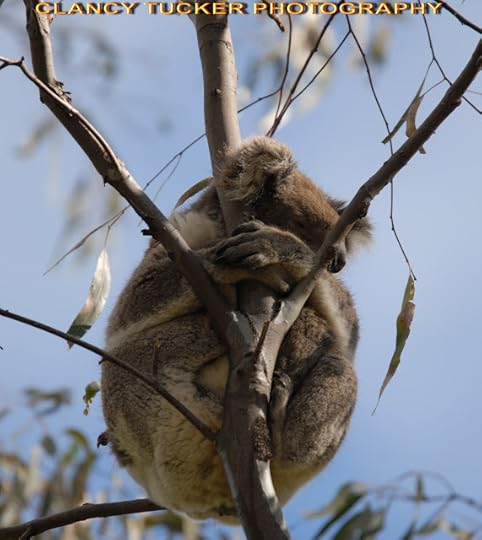
Published on October 21, 2016 13:03
October 20, 2016
21 October 2016 - KANGAROOS

KANGAROOS
G'day folks,
Welcome to some interesting facts about kangaroos.
A male kangaroo is called a boomer
A female kangaroo is called a flyer
A baby kangaroo is called a joeyThe word kangaroo derives from the Guugu Yimithirr word gangurru, referring to grey kangaroos. The name was first recorded as "Kangooroo or Kanguru" on 4 August 1770, by Lieutenant (later Captain) James Cook on the banks of the Endeavour River at the site of modern Cooktown, when HM Bark Endeavour was beached for almost seven weeks to repair damage sustained on the Great Barrier Reef.
Guugu Yimithirr is the language of the people of the area.
A common myth about the kangaroo's English name is that "kangaroo" was a Guugu Yimithirr phrase for "I don't understand you." According to this legend, Lieutenant Cook and naturalist Sir Joseph Banks were exploring the area when they happened upon the animal. They asked a nearby local what the creatures were called. The local responded "Kangaroo", meaning "I don't understand you", which Cook took to be the name of the creature.
The Kangaroo myth was debunked in the 1970s by linguist John B. Haviland in his research with the Guugu Yimithirr people.
On the Australian coat of arms the Emu and the Kangaroo were selected as symbols of Australia to represent the country’s progress because they are always moving forward and never move backwards.
Kangaroos are the largest marsupial mammals. They belong to the Macropodidae family.

There are 47 varieties of kangaroo, ranging in size from the two-pound rock wallaby to the 6-foot, 300-pound red kangaroo.
Kangaroos usually have one young annually. The young kangaroo, or joey, is born alive at a very immature stage when it is only about 2 cm long and weighs less than a gram. Immediately after birth it crawls up the mother's body and enters the pouch. The baby attaches its mouth to one of four teats, which then enlarges to hold the young animal in place. After several weeks, the joey becomes more active and gradually spends more and more time outside the pouch, which it leaves completely between 7 and 10 months of age.
The Kangaroo moves by hopping on its powerful hind legs. It uses its thick long tail to balance its body while hopping. A kangaroo can hop at up to 60kmh (40mph). It can also leap over obstacles up to 3m (10ft) high. Because of the unusual shape of its legs and its bulky tail a kangaroo can't walk or move backwards very easily. Kangaroos are found in Australia, Tasmania, and New Guinea.
They are grazing animals that eat grass, young shoots and leaves of heath plants and grass trees. Kangaroos need very little water to survive and are capable of going for months without drinking at all.

The kangaroo usually rests in the shade during the day and comes out to eat in the late afternoon and night when it’s much cooler. It eats mostly grass. It needs very little water to survive. It can survive without drinking for months.
The Kangaroo moves by hopping on its hind legs using its tail for steering and balancing while hopping at speed up to 40mph/60kmh. When a kangaroo is moving slowly the tail is used as an extra leg and supports the kangaroo when it is standing on its hind legs. Most kangaroos can only move both back legs together and not one at a time.
A male kangaroo is called a buck. It is also commonly called a "boomer" or an "old man". A female kangaroo is called a doe, or a flyer.
A baby kangaroo is called a joey. Kangaroos have good eyesight but only respond to moving objects. They have excellent hearing and can swivel their large ears in all directions to pick up sounds. Kangaroos are social animals that live in groups or "mobs" of at least two or three individuals and up to 100 kangaroos.
Kangaroos usually have one young annually. The joey remains in the pouch for nine months and continues to suckle until twelve to seventeen months of age. Kangaroos can have 3 babies at one time. One becoming mature and just out of the pouch, another developing in the pouch and one embryo in pause mode. There are 4 teats in the pouch and each provides different milk for the different stages of development.

BODY FACTS:
Kangaroos belong to an order of mammals called Marsupials. In most marsupials, females have abdominal pouches in which the embryonic young continue their development after birth. Kangaroos are the best known of the marsupials. Their long feet have earned them the name Macropod, which literally means "big-footed." Kangaroos move by hopping. When they are at rest, their body is sometimes positioned like a tripod, using the hind legs and tail. Kangaroos also walk on all "fives."
The front legs and tail support the body while the hind feet move forward.

BABY FACTS:
At about one month, the tiny embryonic kangaroo emerges from its mother's body and slowly climbs up her abdomen and into her pouch. Once inside the pouch, the newborn latches onto a teat (nipple) which swells inside its mouth. Newborn marsupials do not have the ability to suck. Muscular action from the teat squirts milk into the baby's mouth. Newborns are about the size of a Lima bean. A baby kangaroo spends 7-8 months living and growing inside its mother's pouch. The baby then becomes active outside the pouch, returning only to feed.
When that happens, another baby joey can be born. Then two types of milk can be produced, one for the active joey, and one for the still developing joey inside the pouch. Kangaroos also have a reproductive adaptation called "delayed implantation." The fertilized egg will cease development and wait. Depending on the growth of the joey in the pouch or the weather that season, the fertilized egg will begin development when the mother kangaroo is ready.
Eastern grey kangaroos generally give birth to one infant at a time but twins have been known to occur.

Clancy's comment: Marvellous nature, eh? If you get the chance to watch a video on the birth of a kangaroo, do it. It's quite gob smacking.
I'm ....


Published on October 20, 2016 14:36
October 19, 2016
20 October 2016 - Dr. VICTOR CHANG

DOCTOR VICTOR CHANG
G'day folks,
Victor Peter Chang, AC, was a Chinese-born Australian cardiac surgeon and a pioneer of modern heart transplantation. Born in Shanghai to Australian-born Chinese parents, he grew up in Hong Kong before moving to Australia.
As a gifted surgeon, respected humanitarian and skilled campaigner, Dr Victor Chang was a pioneer of the modern era of heart transplantation.
His achievements include developing Australia’s National Heart Transplant Program at St Vincent’s hospital, which has since performed more than 1200 successful heart, heart-lung, and single lung transplants since 1984. He also saw the incredible value of research – playing a key role in development of an artificial heart valve and, in later years, an artificial heart.
Victor Chang (Yam Him) was born in Shanghai of Australian-born Chinese parents. He came to Australia in 1953 to complete his secondary schooling at Christian Brothers College, Lewisham. He graduated from Sydney University with a Bachelor of Medicine, Bachelor of Surgery in 1962.
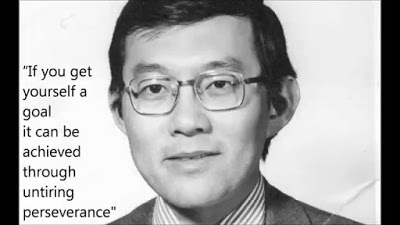
In 1966 Victor became a Fellow of the Royal College of Surgeons at the age of 30. Initially he trained in general surgery in England, but he commenced serious training in cardiac and thoracic surgery at the Brompton Hospital for Chest Diseases in London. It was in London that he met and married his wife, Ann. After two years at the Mayo Clinic in the U.S., where he was chief resident, he returned to Sydney in 1972 to join the elite St Vincent’s cardiothoracic team, which included Dr Harry Windsor and Dr Mark Shanahan. In 1973 he was made a Fellow of the Australasian College of Surgeons and in 1975 he became a Fellow of the American College of Surgeons.

A pioneer of the modern era of heart transplantation, Victor Chang was responsible for the establishment of the National Heart Transplant Unit at St Vincent’s Hospital in 1984, lobbying politicians and raising funds for its ongoing work.
During the 1980’s he lectured extensively in China, Hong Kong, Indonesia, Singapore and Malaysia. He founded the Australasian-China Medical Education and Scientific Research Foundation which sponsored South-East Asian doctors, nurses and students to work in Australia and take improved skills and quality of care back to their home countries.
At the same time, he helped teams from St Vincent’s travel to China, Singapore and Indonesia where they shared their medical, surgical, nursing and hospital administration expertise.
In 1986 Victor Chang was awarded a Companion of the Order of Australia and the University of New South Wales awarded its highest degree of M.D. Honoris Causa for “scholarly achievement and humanitarian endeavour”.
Victor Chang died in tragic circumstances in Sydney on 4 July 1991.

He was an Honorary Professor of Surgery to the Chinese Academy of Medical Science in Peking; an honorary Professor of Surgery to Shanghai Medical School; official advisor on cardiac surgery development in Indonesia; and a member of the Australia China Council.
In 2000, Dr Victor Chang was named Australian of the Century by the people of Australia.
He is remembered as a quiet, charming man – much loved by his patients and his friends, his wife Ann and his children Vanessa, Matthew and Marcus.

Clancy's comment: I recall when this man was killed. What a waste of a bright human.
I'm ...

[image error]
R.I.P
Published on October 19, 2016 14:24
October 17, 2016
18 October 2016 - THE AUSTRALIAN KOALA
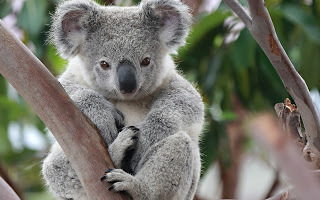
THE AUSTRALIAN KOALA
G'day folks,
Today I introduce one of our favourite animals. The koala is an arboreal herbivorous marsupial native to Australia. It is the only extant representative of the family Phascolarctidae and its closest living relatives are the wombats.
Koalas aren't bears as many people are led to believe. They aren't even related to bears.The koala is related to the kangaroo and the wombat. The koala is a marsupial mammal. The reason the koala is called a koala bear is because the koala looks like a teddy bear.
The koala's scientific name is Phasclarctos Cinereus.
Now there are only 2,000 to 8,000 koalas in the wild! Although not officially classified as endangered, the population of Australian koalas has dropped by 90% in less than a decade. This is due to the destruction of the koala's natural habitat, a narrow crescent on the eastern coast of Australia.
Logging, agriculture and urban development have not only reduced the area available to them, but added other dangers. The koala's habitat has been criss crossed by roads, resulting in many road kills and attacks by neighboring pet dogs are frequent. Disease, too, has taken its toll on the koala.

FACTS:
The koala's nickname is a Native Bear.
The koala is a marsupial mammal.
They are warm-blooded.
The koala's young is called a cub.
The koala's young are born alive.
Koalas drink milk from the mother.
The koala breaths oxygen from air.
The koala might look cuddly but the koala has very sharp teeth and very sharp claws.
The koalas have white on the underside and gray on the rest of its body.
The koala has big ears and a big nose.
The mother has a pouch.
The koala has very thick fur.
The adult koala generally grows to 25 - 30 inches long.
The koala is very small when it's just born.
After 1 month the cub is 1 cm. long.
The koala weighs 15 to 30 pounds.
One cub is born at a time.
The koala cub stays in the mother's pouch for 5 months.
The koala cub is blind when it's born.
Koalas breed in the summer.
Koalas live for 20 or more years.
The koala can run as fast as a rabbit.
Koalas sleep for up to 19 hours.
Koalas live on the East coast of Australia.
They live and sleep in the eucalyptus trees. It's hot, light and dry here.
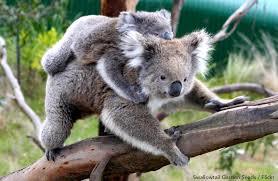
HISTORY:
Mating occurs Nov-Feb in the south, Sep-Jan further north. Gestation about 35 days; single young weigh about 1/5 oz. and are about 3/4 inches long. Newborn crawls from cloaca to pouch and attaches to a nipple to complete its development. The koala Leaves the pouch first at about 5.5 months, permanently at about 8 months. The young joey then clings to it's mother's back or stomach, sticking it's head into the pouch to feed. During weaning the joey eats partially-digested eucalyptus that merges from mother's cloaca,
thus receiving bacteria needed for digestion as well as food.
Life span 12+ yrs (wild) 16+ yrs (captivity).The largest koalas weigh over 10 kg and are found in Victoria while the smallest live in North Queensland and weigh only 5.5 kg. Koalas are found between these two areas, but only where enough suitable trees have been left.
Koalas also communicate with each other by making a noise like a snore and then a belch, known as a "bellow".
Koalas usually only have one cub per year. Older females will usually have one every two years.
Koala babies are known by several names. "pouch young", "back young", "joeys" and "cubs".
When koalas are born they are only 2 centimeters long, which is about the same as a jellybean.

Clancy's comment: I've seen many of them, but they are fairly difficult to photograph because they generally sit, dozing high up in trees.
I'm ...
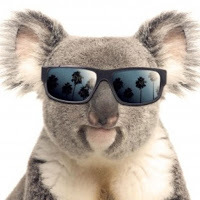
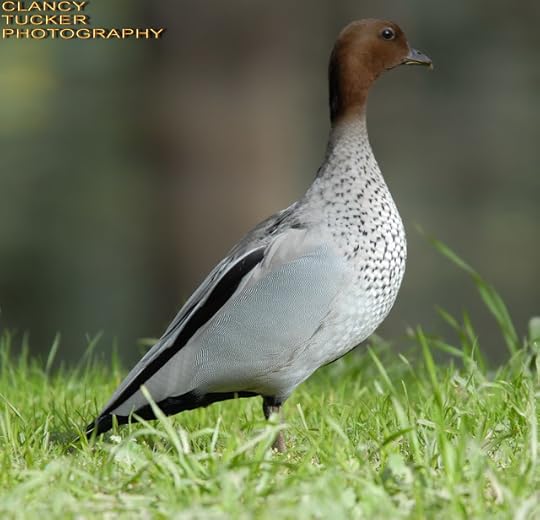
Published on October 17, 2016 13:07
October 15, 2016
16 October 2016 - Dr. DAWN CASEY

Dr. DAWN CASEY
G'day folks,
Welcome to one of the most influential indigenous women in Australia. To some she is known as a “person of great distinction”, a “respected figure”, and to others, a “cultural warrior”.
There is no doubt, however, that Dr Dawn Casey is a visionary in the preservation and promotion of Indigenous culture. She has been recognised nationally and internationally for her groundbreaking work as the Director of the National Museum of Australia, bringing Indigenous culture into the spotlight and to the masses.
Dawn is also an accomplished administrator, having succeeded in a number of high profile roles in Commonwealth Government and Museums. She will bring all this experience and skill to her new role as Chair of Indigenous Business Australia, formally announced by the Minister for Families, Housing, Communities and Indigenous Affairs, the Hon Jenny Macklin during NAIDOC Week 2009.

Like many of her contemporaries, Dawn is a battler, and rose to the top from humble beginnings. Born in 1950 her father was a stockman and mother a cook from Croydon, North Queensland. When she was young the family lived in a cramped shack on the outskirts of Cairns. Here, her mother cleaned houses and her father worked as a garbage collector.
Despite their hardship, Dawn recalls that growing up in Cairns was “a joy” with her and her brothers involved in sports. Her parents insisted that she attend school and did not tolerate absenteeism. Dawn recalls never feeling different to the other children until high school where she was told she couldn’t do the subjects that she really wanted to, like French, on the basis of being Aboriginal. Instead, Aboriginal girls were encouraged to study sewing and cooking to prepare them for domestic employment, with teachers maintaining that ‘you Aboriginal children will leave school before you reach Grade 10’. Dawn’s parents insisted she return to the school and fight her battles. These experiences ignited the determination in Dawn, a determination that would assist her throughout her career.
After leaving school at 14, Dawn was married and pregnant by 16. Working as a cleaner she put herself through business college, and secured her first role in the public service at the Commonwealth Department of Education, Cairns. She rose rapidly to senior posts in the Commonwealth Public Service, including AusAid, executing some impressive projects and honing her skills.
Throughout her childhood and early adult life museums held little interest for Dawn. But this changed when she was director of the Department of Aboriginal Affairs in South Australia, working closely with the director of the Museums. At that time, in South Australia, Indigenous Australians were experiencing a breakdown of culture.

Petrol sniffing was rife and a wide range of anti-social issues were arising in the communities. Dawn funded a program for the repatriation of human remains and secret sacred material back to Indigenous communities. Her hope was that this would reconnect Indigenous people to their culture, and she found she experienced a strong reconnection of her own in the process. This helped forge her commitment to museums and the preservation of Indigenous culture.
It was Dawn’s work on the National Museum of Australia (NMA) in Canberra that cemented her reputation. Recruited in 1999, she managed the transition of the museum from an organisation with 40 staff and an annual budget of $4 million, to a fully operational museum with 210 paid staff, 200 volunteers, and an annual budget of $43 million. The museum had approximately 2 million visitors within the first two and half years of opening. Building was completed on time and on budget – a rare and remarkable achievement for a major public sector building project – and the NMA opened as a Centenary of Federation project in 2001. The significance of this achievement was commemorated by the builders of the museum who presented Dawn with a framed piece of the Berlin Wall, on which was engraved, ‘For making the impossible possible’.

Dawn revelled in her role with the NMA. She enjoyed working for an institution where she got to “share with millions of visitors including school children, the rich, complex, ancient, sophisticated and enduring Indigenous culture, together with the long struggle for recognition and the impact of the removal of children, with people who come through museums; because museums are trusted organisation and, if you do it well, you change attitudes.”
Although the NMA was a success, in 2003 the Howard Government decided not to renew Dawn’s contract as Director, a controversial decision that was met with and accusations of racism among the general public and the Museum fraternity. Ironically, not one month after her dismissal Dawn was awarded a Public Service Medal for her “remarkable achievement” in outstanding public service.
After a brief stint as a cultural consultant to the Victorian and West Australian governments, in 2005 Dawn became the CEO of the Western Australia Museum before moving to the position of Director of the Powerhouse Museum in Sydney in 2008. Dawn’s appointment to the Powerhouse was seen by some of her colleagues as risky and bold, but Dawn was excited by the chance to live in Sydney and take on the significant challenges at the Powerhouse with her characteristic passion and dedication.

In NAIDOC Week 2009, Dawn officially commenced another new role in Indigenous affairs as the Chair of IBA. At the annual IBA NAIDOC breakfast on 10 July 2009, she said “I am attracted by the opportunity to influence the commercial and economic aspects of Indigenous development. My career has always focussed on highlighting areas where improvements are possible and I believe the building blocks that underpin economic development stem from creating opportunities and a better future for our people.”
Dawn recollected a conversation with her mother after her contract at the NMA was not renewed, in which her mother asked “Dawn, weren’t you working hard enough? After 25 years in the Commonwealth Government you’re leaving?” Dawn said, “I believe she’s looking down from up there somewhere and sighing with relief that I’ve been accepted back into the Commonwealth fold.”
She has been welcomed with open arms by IBA, with IBA General Manager, Ron Morony, saying “The executive team and I are pleased with this appointment and it gives us a basis to move forward with confidence.”
Dawn Casey has had an influential, distinguished and at times controversial career. But despite the numerous awards, medals and accolades she remains a modest, humble, and carefree role model. She is a treasure to Indigenous and non-Indigenous Australians and IBA feels privileged to have her as its new leader.

Clancy's comment: Go, Dawn Casey. What a high achiever for a woman who was pregnant at 16, working as a cleaner. Love ya work!
I'm ...


Published on October 15, 2016 13:42
October 14, 2016
15 October 2016 - AUSTRALIAN PELICANS

AUSTRALIAN PELICANS
G'day folks,
Today, I introduce another of our bird species in Australia. The Australian pelican is a large waterbird of the family Pelecanidae, widespread on the inland and coastal waters of Australia and New Guinea, also in Fiji, parts of Indonesia and as a vagrant in New Zealand.
The two Australian Pelicans in the wetlands area of Wild Sea were found in the wild with injuries and brought to Melbourne Zoo for treatment. They have remained at the Zoo ever since. Although pelicans are found over large parts of Australia, for many city-dwellers, the Wild Sea at the Zoo is a rare opportunity to see these delightful birds.
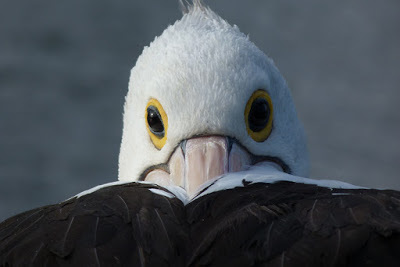
Australian Pelicans are not a species presently at risk. However, many individual birds are at risk from fishing waste: hooks, fishing line and nets abandoned in areas where these and other marine wildlife live. Your local council or community can play a big part in protecting marine wildlife by installing Seal the Loop bins to collect fishing waste and help reduce rates of marine wildlife entanglement.

Australian Pelicans are found throughout Australia, Papua New Guinea, Solomon Islands and Indonesia. They will travel great distances to find food and may form large flocks of hundreds of birds. These flocks will sometimes work together to capture food, driving fish into shallow water where they can more easily be caught.

Pelicans have very wide wingspans: up to 2.6 metres. Their most characteristic feature of course is their long bill (40–50cm) and throat pouch.

Clancy's comment: I've seen many of these whopping birds whilst fishing on inland waterways, and also at sea. They are an interesting bird to observe. Looking up at them whilst in flight, they have often resembled small planes. And, watching them eat is gob smacking.
I'm ....


Published on October 14, 2016 13:35
October 13, 2016
14 October 2016 - SALLY MORGAN

SALLY MORGAN
G'day folks,
Welcome to another well known Aussie indigenous author and artist. Sally Jane Morgan is an Australian Aboriginal author, dramatist, and artist. Morgan's works are on display in numerous private and public collections in both Australia and around the world.
Sally Morgan is recognised as one of Australia's best known Aboriginal artists and writers. She is one of a number of successful urban Aboriginal artists.
Sally was born in Perth in 1951, the eldest of five children. As a child she found school difficult because of questions from other students about her appearance and family background. She understood from her mother that she and her family were from India. However, when Sally was fifteen she learnt that she and her sister were in fact of Aboriginal descent, from the Palku people of the Pilbara.
This experience of her hidden origins, and subsequent quest for identity, was the stimulus for her first book "My Place" published in 1987. It tells the story of her self discovery through reconnection with her Aboriginal culture and community. The book was an immediate success and has since sold over half a million copies in Australia. It has also been published in the United States, Europe and Asia.
Her second book "Wanamurraganya" was published in 1989. It is the biography of her grandfather, Jack McPhee. She has also written five books for children.
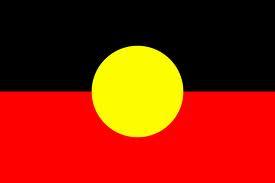
As well as writing, Sally Morgan has established an international reputation as an artist. She has works in numerous private and public collections in Australia and the United States, including the Australian National Gallery and the Dobell Foundation collection. Her work is particularly popular in the United States.
She has received many awards, including from the Human Rights and Equal Opportunities Commission. As a part of the celebration in 1993 of the Universal Declaration of Human Rights, her print Outback was selected by international art historians as one of 30 paintings and sculptures for reproduction on a stamp representing an article of the Declaration.
My Place remains her most influential work, not only because of its very wide popularity but also because it provided a new model for other writers, particularly those of indigenous background.
She is currently Director of the Centre for Indigenous History and Arts at The University of Western Australia.

Clancy's comment: Go, Sally!
I'm ...

BREAKING: His Majesty King Bhumibol Adulyadej
of Thailand has died.
It is a sad day for Thailand, and for many farangs (foreigners) like me who had great respect for their king. I've never known a leader so loved and revered by an entire nation. An extraordinary man who sincerely loved his people. This is a photograph of the king that sits on this blog every day. Amongst other talents, he was a great photographer.
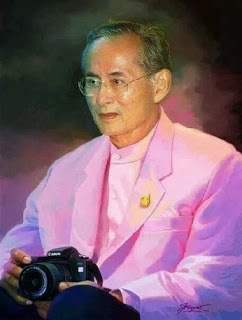 REST IN PEACE
REST IN PEACE
Published on October 13, 2016 13:30
October 12, 2016
13 October 2016 - THE MOLLY MAGUIRES
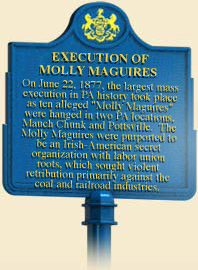
THE MOLLY MAGUIRES
G'day folks,
The Molly Maguires was an Irish 19th-century secret society active in Ireland, Liverpool and parts of the eastern United States, best known for their activism among Irish-American and Irish immigrant coal miners in Pennsylvania.
In the latter half of the 19th century, Schuylkill County, Pennsylvania, was an area rife with violence. Between 1861 and 1875, a series of violent assaults, arsons and murders was blamed on a secret society of Irish immigrants known as the Molly Maguires. The group had originally emerged in north-central Ireland in the 1840s as an offshoot of a long line of rural secret societies including the Whiteboys and Ribbonmen, who responded to miserable working conditions and evictions by tenant landlords with bloody vengeance.
Faced with the prospect of starvation during the Great Potato Famine, more than a million Irish emigrated to America, where a large concentration settled in the anthracite coal region of Pennsylvania in search of work. Irish Catholics were routinely met with discrimination based on both their religion and heritage and often encountered help wanted signs with disclaimers that read, “Irish need not apply.” Accepting the most physically demanding and dangerous mining jobs, the men and their families were forced to live in overcrowded, company-owned housing, buy goods from company-owned shops and visit company-owned doctors. In many cases, workers wound up owing their employers at the end of each month.
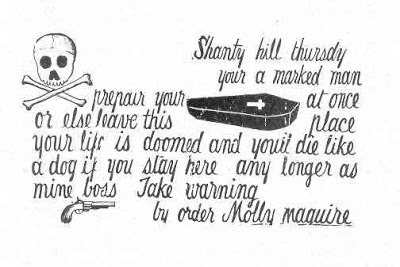
When the Civil War broke out and miners were drafted to join what they perceived to be “a rich man’s war,” they began to rebel. “Coffin notices” threatening death, allegedly penned by Molly Maguires, were delivered to mining supervisors and scabs who planned to fill their roles during strikes, and as working conditions worsened in the 1870s, the violence escalated. In all, 24 mine foremen and supervisors were assassinated.
In 1873, Franklin B. Gowen, president of the Reading Railroad, hired the Pinkerton Detective Agency to infiltrate and destroy the Molly Maguires, whose union organizing became an impediment to increasing railroad profits. Using the alias James McKenna, native Irishman James McParlan spent two and a half years living alongside the coal miners, eventually gaining their trust. Despite the conflict of interest, Gowen served as the chief prosecutor during the subsequent trials. Based almost entirely on McParlan’s testimony, 20 men were sentenced to death—10 of whom were executed on June 21, 1877, also known as Black Thursday.
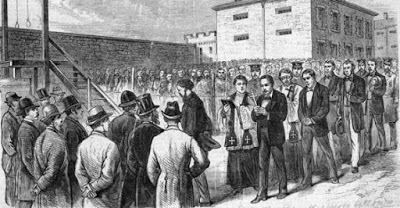
Although the existence of the Molly Maguires as an organized band of outlaws in America is still debated, most historians now agree that the trials and executions were an outrageous perversion of the criminal justice system. In 1979, more than 100 years following his hanging, John Kehoe—the supposed “king” of the Molly Maguires—was granted a full pardon by the state of Pennsylvania.

Clancy's comment: Go the Irish!
I'm ...


Published on October 12, 2016 12:58



